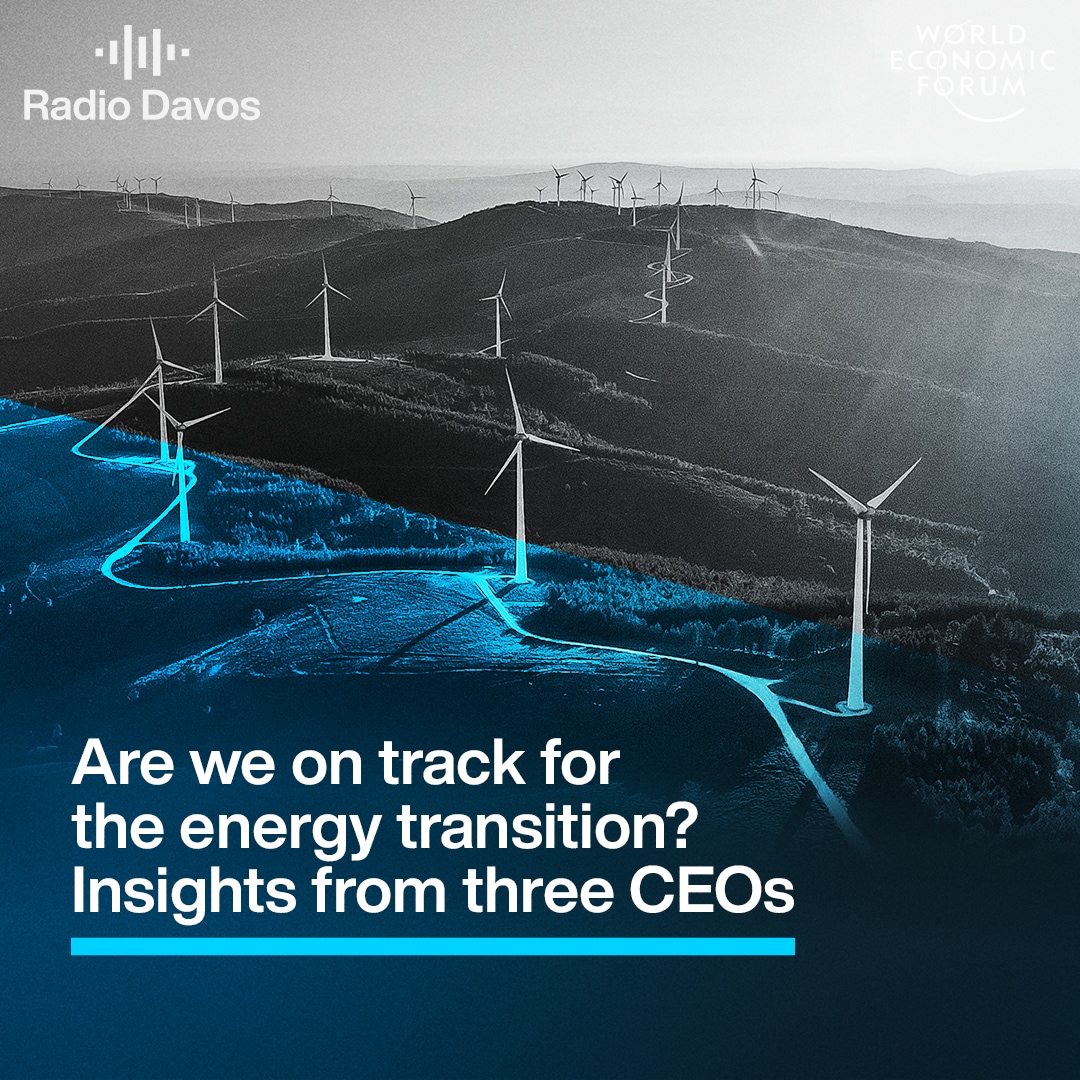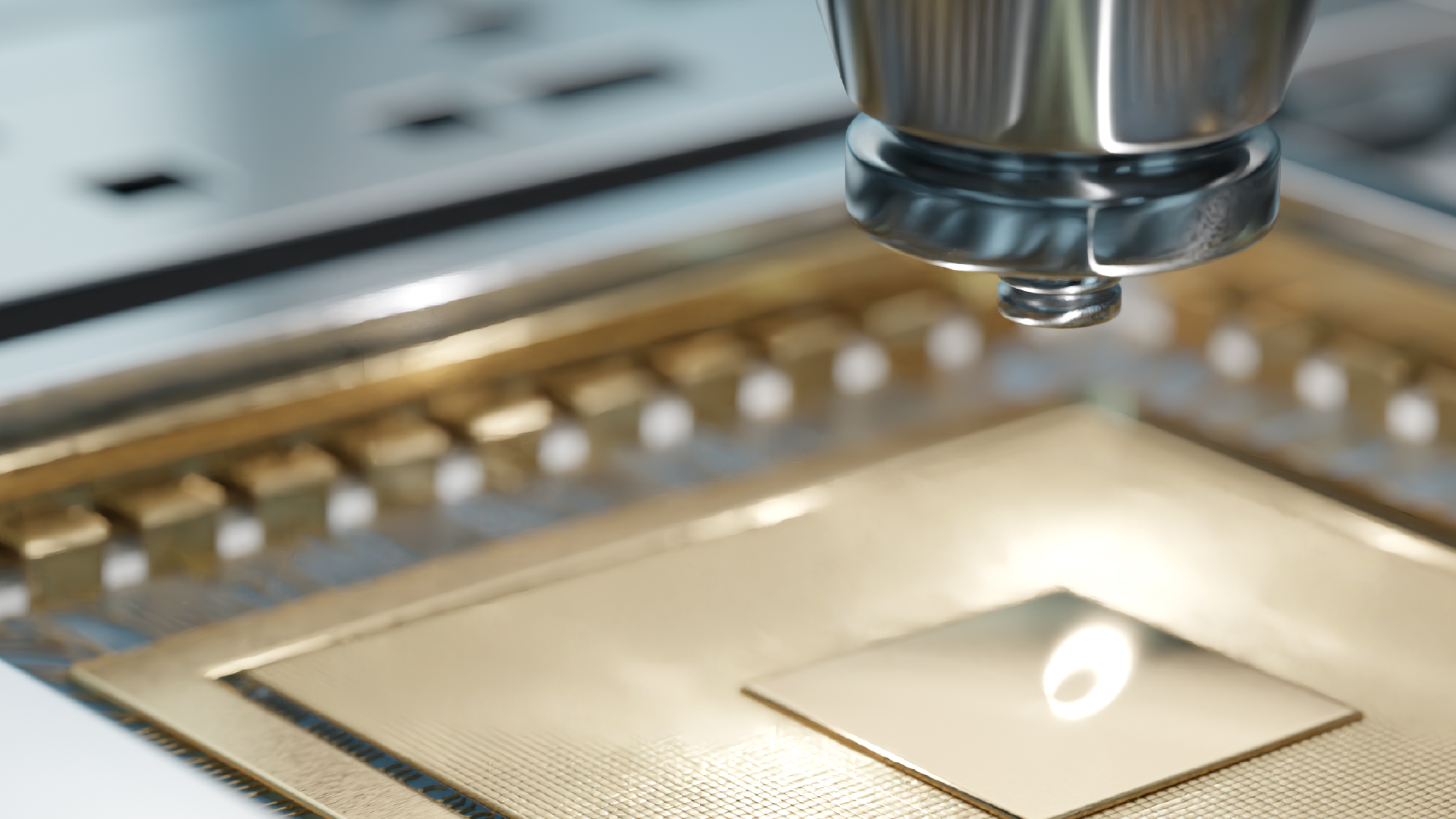Neurotechnology could help billions of people. Has its time come?
Scroll down for full podcast transcript - click the ‘Show more’ arrow
Electronic devices that tap into a human’s nervous system have been around for decades to help, for example, paralysed people move and deaf people hear. Now, a new generation of neurotechnology promises to revolutionise treatments for a range of conditions that afflict billions of people.
We look at the benefits and assess the risks with Jen French, a campaigner for access to neurotechnlolgy who has been using a device for 25 years since a snowboarding accident made her quadriplegic. And Tom Oxley, the CEO of neurotech startup Synchron, explains how 'brain computer interfaces' are giving paralysed patients the ability to use computers and smart phones.
They also address concerns about things such as data privacy, unequal access to health tech, and device 'abandonment'.
Guests:
ポッドキャスト・トランスクリプト
Robin Pomeroy, host, Radio Davos: Welcome to Radio Davos, the podcast from the World Economic Forum that looks at the biggest challenges and how we might solve them.
This week, we 're talking about neurotechnology, the devices that tap into humans’ nervous systems that have huge a huge array of possibilities to help vast numbers of people with all kinds of problems.
But the technology also has of big challenges.
In this podcast, we're hearing from two people. We're going to hear from the founder of a company that makes devices that can enable paralysed people to control a computer or a smart phone just using the power of their own brains.
These things are called ‘brain computer interfaces’. They are relatively new tech, but neurotechnology has been around for decades, as we hear from our first guest.
Jen French was paralysed 25 years ago in a skiing accident. It made her quadriplegic. She had an implant into her nervous system which enables her to stand up. SHe has 25 years of experience of having neurotechnology. She knows about the pros and the cons and she will tell us about both
This is Jen French. She is the founder of the Neurotech Network, an organisation that advocates for access to neurotechnology.
Robin Pomeroy: Hi Jen, how are you?
Jen French, Executive Director, Neurotech Network: Good. How are you, Robin?
Robin Pomeroy: Very well, thank you. So delighted you could join us. Why don't you just explain to us, before you even tell us who you are and what your story is, what is neurotechnology?
Jen French: So neurotechnology, I guess the overarching definition of it is the interaction of electronics with the human nervous system. So it's kind of this overarching umbrella, various types of modalities, such as, you mentioned, brain-computer interfaces, vagus nerve stimulation, cochlear implants, sacral nerve stimulation or spinal cord stimulator. There's a lot of different modalities, but neurotechnology is the overarching umbrella of those various types of technologies.
Robin Pomeroy: Tell us about yourself then, why are you so interested in this issue?
Jen French: I fell in love with this technology really when I first discovered it when I was injured with a spinal cord injury. So 27 years ago I had a snowboarding accident, went down a 40-foot embankment, hit a bunch of trees and came out as a quadriplegic.
So that drastically changed my life, from being a very active person to no longer being able to do the average things that you just did today, like brush your teeth or make a cup of coffee or a cup a tea or get dressed. I had to learn how to do all those things over again in a paralysed body.
And really when I was, was in rehabilitation, my physical therapist introduced me to surface stimulation to help restore gross hand function for me. So I do have some hand function, not completely, but that was my first introduction to it.
And then, you know, I was told I would never walk again, I'd never work again. There was a lot of things I wouldn't be able to do, but I did find a clinical study in Cleveland, Ohio in the United States that allowed me to get an implanted neuroprosthesis. They gave me a lot of function back that I have today.
Robin Pomeroy: I've seen your TED Talk, Jen, and you demonstrate this to the audience, if I understand, rightly what I was watching there, you press a button, and you stand up. Is that how it works?
Jen French: That's the basic function of it. But when you think about the meat of the system, it's very eloquent. So the designers and the engineers actually capitalise on the beauty of the design of the human body.
So I am implanted with 24 channels of electrodes that go either deep into the muscle tissue where the peripheral nerve innervates the muscle or directly onto the peripheral nerves. And all of those electrodes lead up to receivers that are in my abdomen. And all of that is encapsulated in the body so there's no wires protruding from the skin and you don't see any of that implanted component.
The external component are these little coils that I place over the receivers and then I have an external control unit and that external control unit are the brains of the system. It allows for the circuit boards and the battery power and all of the controls for the implanted system.
So it works very eloquently, but really the design of the system capitalises on the beauty of the human body.
Robin Pomeroy: This was 27 years ago you had your snowboarding accident. How long did it take between then and then getting this system that helps you be more mobile?
Jen French: It was a year and a half after my injury. So when you think about it, it was 25 years ago that I was implanted with this neurotechnology device. So really, when you think about where we were 25 years ago to where we are today, and I'm still using the device.
And what does the device allow me to do? It allows me to use my lower extremities. So. I'm able to stand and move short distances. I have trunk control.
But I think some of the things that people don't see are the medical benefits. It helps me to combat against pressure sores, which are the leading cause of death, one of the leading causes of death, of people with spinal cord injury. It helps with bone density and circulation and muscle spasms. So there's a lot of underlying benefits to the device that I use. And I've been very privileged to be able to use it for this long period of time under a research study.
Robin Pomeroy: And what was your journey to actually getting there because, you know, in the time before your accident, I don't know if you'd come across this kind of technology. I imagine most people won't be aware of what's out there. You had to find out for yourself. Were you being guided towards it? But what was that journey like?
Jen French: Yes, the journey was interesting because really I had no connection to the medical world when I was injured. I was in the finance business and then in the consumer technology business.
And really, I stumbled on this research project, because I was appealing my insurance company, as many people know in the United States, we have private insurance system, we don't have a socialised medical system. So I was appealing my insurance company to get more treatments for surface stimulation. And I was trying to find evidence about the medical benefits. And I stumbled upon this research institution in Cleveland, Ohio, that they said, well, here's a bunch of evidence that we have for what you're trying to use for your appeal. But we also have all these research projects going on. And that's what sparked my interest.
So at the time, we actually moved from New England. I used to live in New Hampshire up in upper United States and moved to Cleveland, Ohio to be able to partake in this research study and to be able to get the device.
I mean it wasn't an easy feat. It's not a fix and go and you'll be able use it. I had to get evaluated. I went through an exercise protocol before I actually went into surgery. The initial surgery It was seven and a half hours. I had eight weeks of recovery afterwards, and then three months of exercise and building up those muscle tissues so I can get to a functional use. So it took a period of time to be able to get to where I am today, but the rewards were, to me, are well worth it.
Robin Pomeroy: Did you have any doubts at the time.
Jen French: Absolutely. Being in the finance world, I had to understand what their underlying funding was. I wanted to understand their structure was. There's lots of risks that come with surgeries. A lot of things can go wrong.
So yes, I had a lot of my doubts. But me being the analytical side, I go through my decision tree of what's the risk versus the benefit and go through decision makings. And I did that with my now husband, we weren't married at the time, but, you know, went through that with him as well, of does this make sense? Are we making the right decision?
So it wasn't an easy decision to just go into a research study and commit so much time, you know money and effort and, you risk your life to be part of a research.
Robin Pomeroy: Am I right in thinking it's still a research study now?
Jen French: Yeah, that's, one of the frustrating parts of this is that this technology never translated out to become a commercial device.
And as we know in the developed world, if you want access to new medical technology, it needs to translate out of a laboratory and be picked up by a commercial entity to make it available, widely available. And in most developed countries, that's the way the system works.
This device you know, was on the track to become commercialised when I was first implanted. But in 2000, the company that was poised to take on and commercialise this technology went out of business.
So I was left without a commercial pathway and, you know it was very devastating at the time. And it's still, I still sit on the edge of, I'm constantly in this research project, I'm constantly left at the will of funders and funding agencies and the research team to be able to keep this going.
So, I've been very fortunate to be in this research study, but again, it's not widely available. There's not a lot of people that have it. And I've seen the benefits of it, and I think that's what's really frustrating about it.
Robin Pomeroy: You're not just concerned for yourself, you're an advocate in this area. You launched something called the Neurotech Network. Tell us what that means to achieve.
Jen French: My aha moment on helping to start the Neurotech Network was, I was at an NIH meeting, the National Institutes of Health in the US, and I was sitting on a panel with other neurotechnology users, early users, a woman with a cochlear implant, another that had a deep brain stimulator used for Parkinson's disease, another person that was paralysed using it for their hands, and we all had the same experience. We all had a difficult time trying to learn about the technology. Not a lot of physicians know about it. You really had to be your own advocate to find out about the technologies.
So we started Neurotech Network to help educate people living with neurological conditions and their frontline clinicians about the technology that's available, what is coming up on the pipeline so that people can make educated decisions.
But you know, we've, we've also seen an evolution of the technology that is just extremely exciting today.
Robin Pomeroy: Well, I was going to say, you're going back to the year 2000. I'm trying to remember what it was like then, you know. The internet was still pretty much in its infancy. We didn't have mobile phones or smart phones. So just the technology that everyone uses in the western world, certainly in the developed world, it's like night and day. There must have been similar transformations in neurotechology.
Jen French: Absolutely. When you think about when I was first implanted, we were back in the days of Windows 98, you know, Windows 95. And we don't we don't even, that's considered archaic today, although I think I'm dating myself.
But well, the evolution of technology is amazing because neurotechnology really got a shot in the arm back in 2013 when the U.S. launched the Brain Initiative, and the EU launched the Human Brain Project. And to follow that are brain initiatives that happen around the world. China now has a brain initiative that they launched in 2016. And later in 2017, the UN headquarters pulled this into an alliance of brain initiatives around the around the world, from Australia to Japan to Korea, the US and EU, and all of that was an incredible investment in this type of technology, but also for us to really have a good understanding of not only the human brain, but also the human nervous system, because that's one area that we really didn't understand.
So when we think about the brain, the spinal cord, all the peripheral nervous systems, this has been an investment made in that research and the technology development. And we're now seeing all of this getting translated out today in exciting technologies that are really addressing neurological conditions that basically have gone untreated for decades.
Robin Pomeroy: We'll get on to what are the most interesting ones in a moment, I just wonder if, let's address the sceptics here. Particularly when you talk about implanting anything into someone's brain, which is not the case with you, I believe. It's into your nervous system, your muscles, particularly in your legs.
But we will be talking later in this programme about brain implants. It gets a lot of people very nervous. I think even before then there was certain scepticism about even the technology you have and even cochlear implants for deaf people to make them hear, and that's been controversial as well. Where do you see the scepticism and the kind of opposition to some of this technology and what do you say to that?
Jen French: You know, I would say that I know I mentioned all the investment that's been made, but I think the real underlying advocacy that comes for this type of technology is that, you know, there are over 3 billion people worldwide, that's 1 in 3 people worldwide live with some type of neurological disease or condition, and a lot of those medical conditions go unmet and underserved. And neurotechnology is a way of being able to address those neurological conditions.
When we think about neurological conditions, it's the leading cause of disability and ill disease burden globally. And we have a technology that can directly address a lot of these conditions that have been unmet.
When we about mental health, when we think of communication, we think sensation, the ability to see and vision, auditory, you mentioned the cochlear implant, even movement that I've been able to benefit from.
But I think we also have to think about the cases of what this technology can do. So think about a person that's living with a major depressive disorder that's on the verge of suicide and has a brain implant that allows them to mitigate those depressive episodes.
Or think about, you know, a gentleman that's with epilepsy that's not even able to get out of the hospital because he's having so many seizures. But can have an adaptive brain implant that allows them to be able to become a functioning member of society. When we think about the cochlear implant, that allows a lot of people to be able to hear and to function the way that we do.
Now there has been a lot of backlash and I think cochlear implants is a great example. When it was first introduced, the deaf community rejected it because they saw it as something that was going against the culture of the deaf community, and rightfully so. And I think part of what we learned in the business side of things was that you know we didn't involve the community in the development of that technology so we had to take step back work with the deaf community to really understand their pushback and be able to redesign the device and redesign how we approach it to deploy it.
And I think that's a really important component is community engagement in the development of devices.
Robin Pomeroy: What excites you about some of these technologies?
Jen French: Yeah, you know, I think there's a couple of different components of this. Now you mentioned the brain computer interface, right? There's implanted devices and there's wearable devices and there's pros and cons to both.
Implanted, devices require a surgery. They require to be inside the body, and wearable devices, you can wear them like a watch, you could wear them like a wristband or a neck band. So there's, a lot of wearables as well. And I think they both have a place in treatment.
You also mentioned brain interfaces, compared to other neurotechnologies. Brain interfaces, we know from the research that's been done under these brain initiatives is that the brain is really kind of our central control centre, if you will, of the human body. And so many systems are connected to the human brain, but we can do a lot of good on tapping into the human peripheral nervous system or the central nervous system. And there's a lot of effects that we can have with that.
So I think that the point is, is that there's not a one-size-fits-all when it comes to neurotechnology. When we look at various types of conditions, we can adapt the technology to be able to treat that condition.
So for instance, brain, deep brain stimulation has been used for a variety of conditions, for tremors, for Parkinson's disease or essential tremor, but it's also being used for mental health, for depression and OCD. And now it's starting to be used for rehabilitation for stroke.
So there's a lot of different applications that we can use with various types of technologies. And that's what I would say is that that's the beauty of this technology for people that are sceptics. We can adapt the technology to the condition.
And that's another really key development that's happened in neurotechnology is what we call closed loop systems. So now we have the ability to sense what's happening in the nervous system and be able to adapt the stimulation for better treatments. And that becomes adaptive or personalised medicine that you're able to use on your own without having a programme or reprogram a device all the time.
Robin Pomeroy: Can you give us an example? Because I can't imagine being able to programme my own device to do something like that. How would that work?
Jen French: A great example is spinal cord stimulators. They've been used for pain for decades, and they've been always these kind of open loop systems where someone gets it implanted, they have to go into the clinician's office, the clinician programmes it, then they go home, but maybe their condition changes a little bit and they have go back and get it reprogrammed, and that happens quite a bit.
With closed loop systems, now that system has a sensor and a stimulator. So, we programme it so it can sense what's happening in the body and that signal redesigns what that stimulation is going to be so that the system constantly adapts with the body. We know the body doesn't stay the same all the time. It's constantly changing. So the technology that we have today can constantly change with the evolution of our own bodies.
Robin Pomeroy: Let's talk about the thing called abandonment.
We've heard some stories of people having some sort of medical device implanted, and it works well, and then the company goes. You yourself, you were hoping this would be a commercial venture, and that the treatment that you've had would be, instead of being in a research facility, would be available like medicines or medical devices are, usually made in the private sector.
How much of a risk is, Great i'll get this fantastic treatment that's going to give me a new lease of life, and then, a year or two down the line it just stops working there's no to make it work again. Is that a big problem?
Jen French: It's becoming more pervasive of a problem. The abandonment issue is a lingering challenge in neurotechnology.
You mentioned the company can go out of business. What happens when the technology becomes obsolete and somebody has it implanted in them and there's no other alternative? What happens when government leaders decide to pull research funding from clinical trials and people are left with these devices?
So there's a lot of scenarios that build up to what abandonment can be.
This is not a new problem. We've been facing this since the early 2000s when the company that was going to commercialise my device, NeuroControl, went out of business and they had a device for upper extremity. And when that company went out of business, there were a lot of quadriplegics left with devices implanted that they could no longer use.
Around the same time, there was a company called North Star Neuroscience that had an implanted device for stroke rehabilitation, when that company went out of business, they had to explant a lot of people.
Fast forward to 2016, we had Second Sight, which was a retinal prosthesis, allowing people who were blind to be able to see. That company went out of business, leaving a lot people left with abandoned devices.
So this is not a new problem.
But I think it's becoming more pervasive as we develop more and more technologies and we're able see the benefits of it. But we still have this abandonment issue.
And it's one thing, Robin, when we see smartphones getting abandoned, how do we recycle them? But what happens when we have technology that interacts with the humans and then they become obsolete? What do we do with that?
And so I think this is a real important, not only ethical problem, but it's an economic problem. It's a regulatory problem. There's a lot of components that come around abandonment that I think needs to have a multi-stakeholder solution to it and I think as it becomes more pervasive we have to have louder voices to say we need to come up with real solutions for the abandonment issue.
Robin Pomeroy: I suppose you could tackle that with regulation, but there is always the risk that regulation then stifles innovation, and maybe stops some of these things coming up, so is there a balancing act?
Jen French: Absolutely, there is and I don't think regulation is always the solution for everything. I think there's a piece of the design of the technology so that we can easily explant it or replace it or so it becomes interoperable with the next generations. Like we've learned with computers, right? At one point we couldn't transfer data from one computer to another and now we have interoperability. We have to start thinking about that in the design of neurotechnology.
We have to think about how are we going to address this from a clinical standpoint? How do clinicians be able to address these? What about companies? When companies go out of business, there's an economic issue, right?
And also for investors, investors are concerned about this as well.
So I think there's a lot of other pieces to this puzzle and it's not just one and I don't think regulation, only regulation alone, is going to be the key to the solution for it.
Robin Pomeroy: I suppose if you're an investor, investing in a start-up company, you're going to want to know in 10 years time those products will be able to evolve, will still be functional, that you're not letting down those patients, otherwise your investment is a bust.
Jen French: Yeah, I mean, investing is a risky business, right? We know that there's going to be winners and losers, and we know that's there's going to be those that thrive and those that do not. But how do we mitigate the damage, is the real question. How do we meditate the damage that can happen? And investors are obviously, and funders are obviously interested in this because they wanna mitigate the damages as well.
Robin Pomeroy: I'd like to ask you for your most optimistic and most negative, most pessimistic scenario. Should we start with the bad news then go to the good news or should we start with the glass half full? Let's do that.
Five years from now imagine the best possible things are going to happen in the next five years in terms of the technological development, also in terms of confronting those systematic challenges like abandonment, like getting access, getting knowledge out to people. What would you love to see happen?
Jen French: Thanks Robin, I am a half glass full type of person. So yeah, let's start with the positive first.
You know, I'm so excited about neurotechnology and I have been for a long period of time. The technology is becoming more widely available. We're understanding and we have groups working in, you know, underdeveloped countries that are able to deploy this technology. So I think very optimistically, we're seeing the access to the technology, which I think is really important. It shouldn't be only available for wealthy countries. It should be available worldwide.
And also the adaptability of the technology I think, is amazing. My greatest scenario is that we have technologies that are easy to deploy, that people can get into their hands and that they know about. And that closed loop becomes more pervasive so that we start to have more of this personalised medicine.
I can see in the future where we can really solve and mitigate the burden of neurological conditions around the world that impact 3 billion people, that the technologies can provide people with independence and autonomy for the users. And most importantly, most importantly, we have access to it.
And I think some of the global initiatives over at the UN, with the World Economic Forum, are all starting to look at how do we mitigate some of the downfalls that can happen with neurotechnology. And I think that's really an important initiative as well.
So let's go to the glass half empty side..
Robin Pomeroy: I was almost not going to ask you Jen, but, ok, let's go to the glass empty - what could go horribly wrong?
Jen French: We should talk about that, because if we don't talk about the potential risks and the potential challenges, we're not going to find solutions for it.
And I think some of the risks are this, is that it only becomes, the technology only becomes available to wealthy and privileged countries, and that we create even a larger gap in our societies around the world.
I have concerns about data breaches, about how do we take care of the security of the data that comes out of these types of technologies and that these technologies use on a regular basis.
I get concerned about this really powerful technology being used in nefarious ways around the world. So we need to be very careful about that and very strategic on how we deploy the technologies around the world
Robin Pomeroy: Do you want to give some example of what that might be?
Jen French: Well, it could be, for instance, you know, the use of the technologies in defence systems, you know what we might use them, to destroy humanity rather than build it up. And I think that that's my concern. And I think we need to put guardrails around the technology.
And again, I think the worst thing that can happen is that we don't address this abandonment problem, and we really start to look at how we treat human and human rights when it comes to the neurotechnology.
Those are the risks that we have in front of us, but I think they're fully addressable.
Robin Pomeroy: As you mentioned, I think the world I can look for is trying to address them by bringing stakeholders together, academics, businesses, people with personal experiences like yourself.
Before I let you go, Jen, there's so much more we can talk about, but just tell me something more about your experience, because I notice on your CV. In 2012, you were at the Paralympics in London, and you got a medal.
Jen French: I did. I did, yes. I'm proud to say I'm a Paralympian, silver medal in the sailboat racing.
It was an incredible experience to be able to join into the Paralympians and to be able to represent my country worldwide and to be able meet so many fellow athletes and friends from around the world. It was a really incredible experience and London did a fantastic job. The UK did a fantastic job on hosting the games.
Just to bring that back to neurotechnology really quick is that, you know, as I've watched the Olympic games and the Paralympic games over time, we start to see technology start to integrate into not only what Paralympic athletes use, but what Olympic athletes use. And when we start to see swimmers and runners using surface stimulation to loosen up their muscles, we start think of, is this neurotechnology becoming much more pervasive into so many different elements of our lives?
Robin Pomeroy: Were you a sailor before? And were your implants necessary for you to be able to do the sailing?
Jen French: I was not a racer before my injury. I was a windsurfer and cruised on big sailboats, but I took up racing after my injury and I used the standing system on the bigger boats, but I didn't use it for racing, for a couple of reasons. One, saltwater electronics don't necessarily get along.
And number two, in competition, there was still a real question even back in 2012, is the use of the technology an advantage? And I think at some point, the WADA and the various drug enforcement agencies around world sport need to eventually address neurotechnology for sports performance. And it will be interesting to watch how that integrates in the future.
So it'll be fun to watch it as we move forward.
Robin Pomeroy: So you're involved with the work of the World Economic Forum, and the World Economic Forum has these things called Global Future Councils, which are small groups of experts from around the world focusing on an issue. Could you tell us what's happening in this area on that?
Jen French: The Global Future Council on Neurotechnology is really addressing a lot of issues that surround neurotechnology. But I will say this to introduce it, is that we know that there's human flourishing in neurotechnology, we've seen the potential of the technology. And I think we're at this pivotal moment in neurotechnology where it can help reshape society.
We've seen this in the past where the printing press changed the way we had history. Aeroplanes changed the ways we did transportation. Semiconductors changed the way in terms of technology. And I think we're at this pivotal moment of neurotechnology of interacting with the human nervous system. And we're in this pivotal moments right now.
But I think understanding the potential of it, we also understand that we need put guardrails around it so that we have responsible innovation going forward.
And I think that's the important work that the Global Future Councils on Neurotechnology is doing is helping to shape responsible innovation and integration of this technology, but also allowing a means for people, not just people with neurological conditions, but the general public, to be able to evaluate technologies that they can trust.
And that's a really important piece in the global world that we see today is how do we trust these technologies and how do be able to evaluate them to know if they're doing good for good purposes or whether they're being used in nefarious ways. And I think that's the important work of the Global Future Council.
Robin Pomeroy: Jen French, thanks so much for joining me on Radio Davos.
Jen French: Thank you, Robin. It was great to be here.
Robin Pomeroy: Jen French, the founder of the Neurotech Network.
Our second guest on this episode is the founder and CEO of a company called Synchron which makes brain computer interfaces.
I met Tom Oxley at the Forum’s Annual Meeting in Davos last January, to find out what that tech is capable of doing today, and what it might do in the future.
Welcome to Radio Davos Tom Oxley. How are you Tom?
Tom Oxley, Chief Executive Officer, Synchron: I'm great. Thank you.
Robin Pomeroy: Tell us about your company and what it does.
Tom Oxley: Synchron is a implantable brain computer interface company. We are developing a device that is inserted up into the brain minimally invasively using a blood vessel, and it creates a live data stream of real time brain information that is reflective of your intention to control and move your body.
So for people who can no longer move their body, such as those due to paralysis, which is a huge unmet need and medical problem that has no therapy, we have them try to move their body and convert that into a digital output, which can push a mouse around a screen and control a smartphone.
Robin Pomeroy: This is called a brain computer interface, is that right? A BCI.
I was reading an investment report by Morgan Stanley, a note to investors. They are very excited about this. And I'll quote them:
The hype continues to grow. So is now the time for the BCI? What not too long ago felt like science fiction might now become a reality. We're entering a period where brain interfaces would be used to treat a range of human health disorders from motor neurone disease to depression.
End of quote. And I'll just note that Morgan Stanley said, the market, the potential market, for this technology in the United States alone is $400 billion. It's absolutely enormous. Why is the potential, in your opinion, so huge?
Tom Oxley: The are are millions of people with neurological conditions that don't have treatments. Paralysis is an example of that. Three million people in the U.S. with paralysis, 15 million with severe paralysis.
And if your if your body stops working from a range of conditions, stroke, spinal cord injury, ALS, neurodegeneration, multiple sclerosis, a range of conditions, if your body stops working and your brain is still working, you lose the ability to have that critical part of being human, which is your ability to express yourself.
So this technology is a digital mechanism of getting your brain state out of your body and re-engaged with backward technology. So it's really profound and life changing for people with injury or disease.
Robin Pomeroy: Where is the technology right now? It sounds amazing if someone's paralyzed or they have one of these degenerative diseases. They can't get this treatment right now, can they? Where is it at and when will that kind of thing be available?
Tom Oxley: So there's a 50 year history to the emergence of this technology going back to the 70s and 80s for animal work, proving that this might be potentially possible.
And then first human, let's say, experiments in the academic domain around the middle 2000s, 2010s, and now in 2020, clinical trials have begun.
So there are two companies currently in clinical trials of implantable BCIs, with the hope that there will be a market approval, FDA approval in the, it looks like the US will be the first market to get approval, with the FDA holding a major leadership role in regulatory science with BCI.
So I would say before the end of this decade, there'll be market approvals for the technology and available to millions of people.
Robin Pomeroy: FDA is the U.S. Food and Drug Administration, which registers medical procedures to be used. What will be the first illnesses or conditions that will be treated by this?
Tom Oxley: The first wave of BCI is for motor disorders or motor is movement or the control of movement. So it will be those conditions that I just spoke about, the multitude of causes of paralysis or motor impairment where the output is a control mechanism. And if you can think of it like a joystick out of your brain. Once you generate joystick control over something as widely available as Bluetooth, then you can engage with control of a whole range of digital devices.
But that actually speaks to the digital devices of today. I think as as we move, you know, who knows where digital devices will be in 10 to 15 years. So I think if there is an ability to engage directly with the brain, with technology in a way that improves your ability to do that, especially if you have injury or disease, there's going to be growth of this technology that's that's going to be hard to predict over the next decades period of decades.
Robin Pomeroy: Can you describe what abilities this would give to one of these first patients? What would they be able to do?
Tom Oxley: Yeah, the first particular use case that we have zeroed in on is so if you if your hands stop functioning, the number one thing that you're likely to want back is the ability to text message. So then layered on top of that is who would you want to text message primarily? Well, you want to text message that who is helping care for you. So the ability to text message your caregiver remotely means that they no longer have to be in the immediate vicinity of you. They can now leave the house. You can now re-engage with text messaging. So that is the number one starting point. But then you get into you realize.
Robin Pomeroy: How does that work? They just think the text message, please send this message?
Tom Oxley: No, no. We we think about navigating around the keyboard to make selections.
Robin Pomeroy: They're looking at a screen?
Tom Oxley: They're looking at a screen. And they're able to manipulate the cursor on the screen to make a selection and then engage engage with the options on the screen, which may be a keyboard or may be an app.
Robin Pomeroy: How does that differ from what might be available now, because I know we've got eye tracking devices and people can blink to do that kind of thing. What's the major advance?
Tom Oxley: So eye tracking is good for smooth cursor control, but you're not able to easily make selections or click and drag or scroll or turn a device on and off.
If you're using your eyes, you can either do a lag click where it will watch your eye in one particular area, or it'll do blinking. So you're very limited with how you can create inputs. But it is very good at a smooth cursor control around the room.
So actually I think there's going to be a combination effect of these technologies with BCI.
I think of BCI as representing your capacity for decision making. So it enables at the very base case different elements of saying yes or no in whatever domain.
But one thing that we're realizing is a real challenge is, a simple challenge is turning the phone on and off. So we're having to send identify unique identifiers from the brain to devices to actually overcome the security issues.
So if BCI is going to be effective and and now enable independent use, you have to overcome whole system changes. So we're sending different signatures in to do different things. So it's a bit different to eye tracking.
Robin Pomeroy: Can you explain to the layperson how it works?
Tom Oxley: Your brain has a map of different regions that control different parts of your body. So when you try to move your hand versus your knee versus your neck, versus your tongue, different areas of the brain will fire off electrical signatures.
So we have our uses try to move different parts of our body. We map it out and then we push them into particular case strokes or like to think of like function F one, two, three or magnitudes of movements up and down. And then we look for the strongest signatures and then we can have the system running on a very low number of inputs and then they have a training apparatus to learn more and more outputs.
Robin Pomeroy: And you describe the of procedure as noninvasive. Is that right? Which I was very amazed to hear. Because I would have thought anything involving the brain is going to be very invasive. So what do you mean by noninvasive?
Tom Oxley: The origin story for my company was that I saw this technology emerging, but I thought, well, if it requires cutting open the skull, that's a very expensive, lengthy procedure that takes up operating room time.
And if you look at what happened over the last 30 years for stent delivery to treat cardiac diseases, there's now a million stents and a million pacemakers. The reason that capacity for technology delivery scaled in cardiac was because did not in the operating room. They were in the cath lab, in the angiography suite, which is a different part of the hospital day procedure, very fast procedures.
So we took that concept to neuro and said, Well, what if we could use the same approach for interventional cardiology stent type delivery and brought that to the brain?
And so, you know, as of yet, there has not been a open brain surgery procedure, which has scaled of more than low tens of thousands of procedures. Cochlear device for hearing is at about 40,000.
So our view is that if neurotechnology can deliver on the, you saw the market report, the size of the problem is huge.
So to scale, we have to get out of the operating room. And so that was the, that's the concept on Synchron.
Robin Pomeroy: So stents, for anyone doesn't know is, before that technology was created you had to have a bypass operation, right? Open up the chest and put in tubes to bypass a blockage in arteries serving the heart. Now, it's an everyday procedure that goes through the wrist or groin into the heart. You're awake while it happens.
In the case of a stent, it's a little thing that opens up that artery. What is it you're implanting in the brain through this blood vessel?
Tom Oxley: It's exactly what you just described. But our intellectual property is around putting electronics on the stent. So and the stent has a cable attached to it, so it looks like an antenna. And then we bring that down.
So we use the we use the base of the skull, the natural holes in the base of the skull to get up into the brain, have a cable coming down to electronics package left in the chest. It looks just like a pacemaker. And then we use Bluetooth to bring the data stream out of the body.
So it really is inspired by a pacemaker technology. All the manufacturing, all the scalability and the delivery into market.
Robin Pomeroy: What are the risks? People are squeamish about computer brain interfaces. Do you understand why people might be hesitant, and what do you say?
Tom Oxley: So first of all, we use the veins, not the arteries. So if you block an artery, you cause a stroke. If you block a vein, a vein is the drainage system from the brain. So it's much more forgiving. We haven't had any, we've had ten users implanted at this point. None have had that issue. But that's a risk. But it's treatable risk.
So in terms of the safety profile, this is safer than putting in a typical stent that you would in the brain. Because we're on the venous side.
I think I think people rightly have questions about how security protocols and privacy works with the way the technology goes. So I can understand that that is an ongoing concern.
So, you know, the answer to that is that the FDA has very strict security protocols, end to end encrypted, de-identified. But I would still make the point that it would be the same as having, if there was a security breach, it would be the same if you were using your mouse or keyboard, as someone tracking your activity on your mouse and your keyboard.
It can't read your thoughts. It can't read what you're thinking.
So it's this first wave is around what are you trying to control or move in that moment?
Robin Pomeroy: Right, you talk about the Internet of Things. I would be hesitant about having a smart fridge, let alone my own brain being potentially controlled from outside.
Tom Oxley: But I think that's from where you're sitting right now. I think if you had lost your ability to move your hands, what what our users are saying, if once you lose your ability to text message and engage in digital technology, your set of priorities completely shift. And at that point you are looking for an answer to return your freedom of expression.
Robin Pomeroy: What about the possibility, I remember a story from a couple of years ago about a company that made retinal implants for blind people. And that company, I'm only vaguely remembering this...
Tom Oxley: Second site. And the technology was left in bodies. And there was a Wall Street Journal article.
It's true that there's there's a concern around with neurotechnology. What happens if it fails and it gets left behind.
So we we all have things left in our body now. Most of the devices say a hip replacement or knee replacement or things left in blood vessels or stents. There's now a lot of material that goes into the body to treat conditions. The materials that we use to treat these conditions are very safe. And so, we're 12 years into this journey. And so much of that is because we have to spend most of that time making sure this technology is safe.
I guess where I'm going is, if you have a condition where you take on that risk when you get started and there is a chance that it will not work, there's a chance with every therapy that it will not work. So the key question is, is it going to put me at risk ongoing?
I think what was challenging with the sight system is that if people can see it from the outside, if it's visible then and you can't remove it, then that's that's the thing.
I think if it's invisible, it's a little bit less than how many of the components can you remove versus not remove. These are all important questions, but it's also a conversation we have with the users at the onset, taking on.
So it comes with the package of consideration of implantable neurotechnology, that things might have to be left behind.
Robin Pomeroy: Where do you see this technology developing? You're talking about, at the moment, offering people who are unable to communicate really with the outside world, they'll be able to communicate really quite well through this text messaging you're talking about. Will it eventually be able to make paralyzed people walk again?
Tom Oxley: Well, actually, last week Nvidia announced this world foundation model concept. And it got me thinking because we had one of our users was watching YouTube and something weird happened on the YouTube video they were watching and when something strange happens, your brain goes, bing, a lot of electrical activity. So it's kind of like a it's like an edge case. Your brain has to learn in that moment and when. So when he got surprised, the cursor pushed over somewhere weird and clicked something and he didn't want that to happen. And we realized in that moment that our ability to do brain inference to make the predictions and what the brain wants to do is very important of the contextual environmental context.
So Nvidia have just announced this. They're going to create this digital twin of the world in preparation for a physical AI layer that's coming. I'm realizing that as as the world moves towards digitized manifestations of the world, people with BCIs are going to engage with the world in ways that is going to be very smooth and reactive.
So what I'm really excited about is our users being able to engage in these digital ecosystems that these foundation models that Nvidia and other companies are going to increasingly create. And there's probably going to be a point in the future, I don't know when, where the BCIs enable engagement with AI in a way that's superior to what the human body can do. In other words, what your hands and mouth and speaking can do. And they're going to be able to understand your context and, you know, understand your emotions and understand your communication.
And so it's, I think we're just at the beginning of this layer that's decades to come. But it's because we can't see the progress of change and the ability to engage with the world is going to change vastly.
Robin Pomeroy: Morgan Stanley was talking about science fiction. What you were just saying reminds me of Avatar, where the lead character is suddenly in a world with an avatar, and engaging in that world. His real body is not. You're talking about that kind of scenario decades into the future, is that right?
Tom Oxley: Well, Nvidia's just announced it. I think they've called it the Omniverse and Cosmos. And so they're building this now.
And the intention within Nvidia was to create a digital ecosystem that can enable training of a robot or something non-human in that world. But actually, if our users go into that world, they can actually train and engage with systems that are not available in the real world and engage in ways that are profoundly relevant for them. So it enables us to learn about how to build better inference models.
So it's this really exciting potential for engagement with those sorts of world foundation models that we're excited about.
Robin Pomeroy: I can really see how that would be amazing. In the world of work 50 years ago people weren't communicating through the internet. A lot of work is done, it's virtual, often we don't think of it as virtual, right? And someone with a medical condition of the type you're talking about could be engaging in entertainment, socializing, gaming, meeting each other.
Tom Oxley: If you go into the app store, the Apple App Store, what you just described were activities of daily living. And so, yes, the the growth from where we are right now in generative the world of generative AI, moving towards agenetic A.I. and then physical A.I. robotics, A.I., there's going to be these layers of digitized options around us and BCI's are going to make seamless interactions with those for AI users. So we're going to be opening up this brain app store type concept to create once we've got these models down to create APIs that enable engagement with all the different versions of the world that you just described.
Robin Pomeroy: If I were quadriplegic, though, from one day to the next. I would just the dream, I guess, of walking again. I'd really value what you're just talking about. But in the physical, real world, I'd want to be able to tell my legs to move and then they would.
Tom Oxley: So there's two ways that'll happen. So step one, you have to build the control language and, you know, lay down a standard. That's the phase we're in now.
Step two is can you control an exoskeleton? So there are there's a company there's several companies that are building exoskeletons right now so that that system could control an exoskeleton.
And then layer three is biological implants that re-engage muscle. That's a very complex biological problem because once the muscles atrophy, getting them back up to strength is very challenging. But I think there'll be a future that will come.
Robin Pomeroy: You feel like you're really at the beginning of a big adventure, a massive journey here?
Tom Oxley: Well, I'm 12 years in for my Ph.D. to where we are now, so it still feels like the beginning. But even where I've come in 50 years into this story, so and there's a long way to go. So, yes, it still feels like the beginning, but it also feels like we've come a long way.
Tom Oxley is founder and CEO of a Synchron. We also heard on this episode Jen French founder of the Neurotech Network.
They are both engaged with the World Economic Forum’s Global Future Council on Neurotechnology - you can find out more on that on the website - there's a link in the show notes.
Please follow Radio Davos wherever you are listening to or watching this - we are making more and more video-podcasts. You can find them on our website and our YouTube channel.
Please follow us so you don't miss an episode and give us a rating or review.
We’ll be back next week, but in the meantime thanks for listening and watching and goodbye.
その他のエピソード:
もっと知る 新興テクノロジーすべて見る
Kiva Allgood and Maria Clara Sayeg Ribeiro
2025年10月31日













